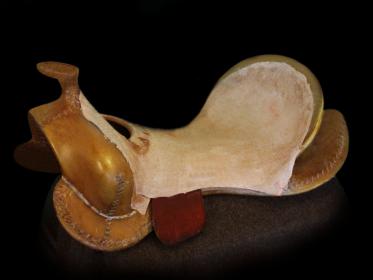One of the differences between an English saddle and western is the “ground”. That is the built up portion on top of the saddle tree:
[ATTACH=JSON]{“data-align”:“center”,“data-size”:“full”,“title”:“Final-ground-2.jpg”,“data-attachmentid”:10744904}[/ATTACH]
“By definition, it is the part of the saddle that is sandwiched between the visible seat leather and the saddle tree underneath. It is usually made of a galvanized piece of sheet metal called a strainer plate, and covered with layers of leather that are shaved down to the desired shape. This shape is what is critical to the usability of the saddle.”
https://caryschwarz.com/the-ground-seat/
Think of it this way: The tree is what distributes weight on the horse’s back. The “ground” is what distributes how the rider’s weight is carried by the tree. From the same link:
“Chuck Stormes once said, “When they say ‘narrow’, what they mean, is ‘comfortable’.” Comfort, he says, is maximizing the contact between leather and rider. That is to say, even distribution of pressure from the crotch on down to where the leg starts to separate from the side of the horse. Incidentally,this is the same goal of fitting the saddle tree to the horse.”
Also see: https://www.mhleather.com/groundseats.html
Your position is driven by the ground because if your legs flow into the ground, it will A) minimize the PSI your body feels, and B) increase your security in the saddle. If you try to sit in a way that conflicts with the ground, you’ll feel hot spots and become less secure.
The ground and stirrups will normally put your feet just in front of your belt buckle. That is NOT wrong, any more than using slack reins is wrong. Western riding is not dressage and the dressage position is not helpful. Feet forward will place your center of gravity further forward without requiring the rider to lean forward. It will allow your weight to sink into the stirrups in a sudden stop or turn. And it will put your leg at the place where the horse’s minimum circumference is.
“So, going back to the idea we started with – some of the weight of the body is carried on the seat bones, some on the thighs, and some in the stirrups…With the result that - at least in this case, though I expect it is a general rule - the center of pressure under a rider on a solid tree (important point, that!!) is not under his seat bones, which people generally use when thinking about rider position, but pretty much at the front of his body.”
Center of pressure under a saddle
You can ride English in Western tack, or ride Western in English tack, but it works best when your riding position and approach matches the tack designed to support that style.



